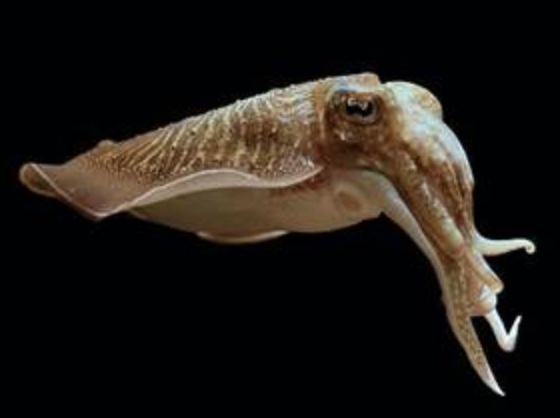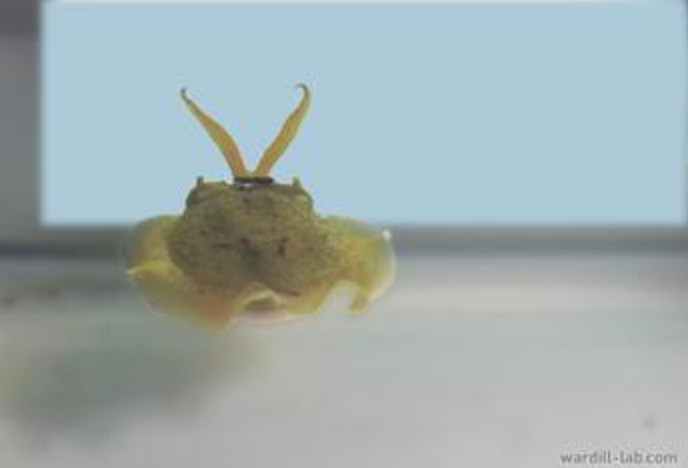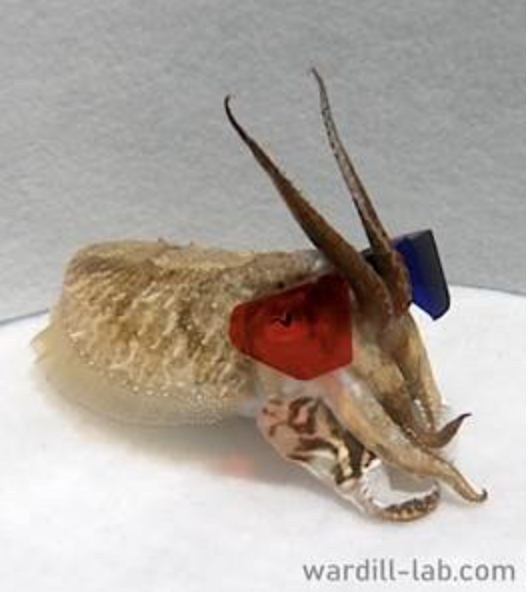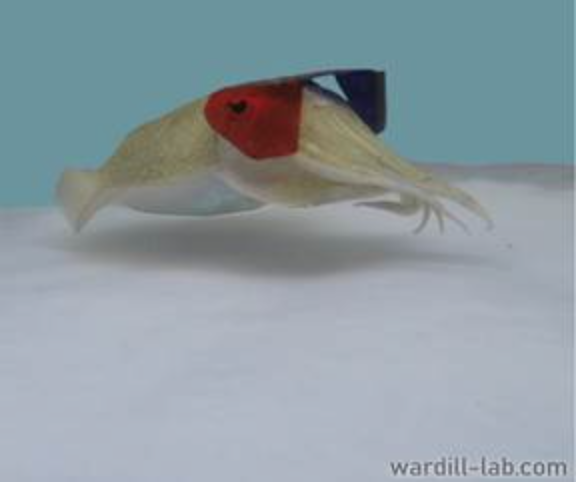Written by: Ben Burford, PhD Candidate, Stanford University
Edited by: Misty Paig-Tran, Assistant Professor, California State University Fullerton
Wardill & Gonzalez-Bellido wanted to put 3-D glasses on cuttlefish
From mantis shrimp striking snail shells to slingshot spiders shooting themselves at flying insects, many of us at SICB report on the results of research that hinges on the cooperation of our study subjects. This was especially true for Trevor Wardill, an Assistant Professor at the University of Minnesota (UMN).
During a Whitman Center Fellowship undertaken at the Marine Resources Center at Marine Biological Laboratory (MBL) in the summer of 2018, Wardill and Paloma Gonzalez-Bellido (also an Assistant Professor at UMN) hoped to test a hypothesis. They wanted to know if cuttlefish use stereopsis to sense depth and 3-D structure, a process that relies on differences between the images produced by the left and right eye.

Stereopsis is common in vertebrates—as you look away from this screen to pick up your cup of coffee, stereopsis is what helps you to navigate that distance and grab the cup (while hopefully not knocking it over). That simple task of grabbing a distant object after looking at a closer screen requires depth perception, and many mammals, birds, reptiles, and amphibians generate depth perception the same way that we do.
However, stereopsis has only been identified in one invertebrate species, the praying mantis. Wardill suspected that cuttlefish might use stereopsis because, unlike other cephalopod molluscs (squids, octopuses, and nautiluses), cuttlefish often focus on the same object with both eyes. Thus, there can be substantial overlap between what the left and right eyes see, a necessary element of stereopsis. Wardill reasoned that the simplest way to test this hypothesis would be to get cuttlefish to wear 3-D glasses.
3-D glasses trick the brain of a visually-driven animal that uses stereopsis. A scenario filmed, photographed, or animated from two side-by-side perspectives (like your eyes), and then projected through two different polarizing filters can be re-separated by your brain when viewed through the corresponding filters. This is where 3-D glasses come in—they separate the left and right perspectives, allowing your brain to focus on the disparities between them and create the illusion of depth.
But when was the last time you heard of cuttlefish wearing 3-D glasses? They don’t for good reasons.
Cuttlefish aren’t amenable to being accessorized
Imagine a squishy pillow animal that can levitate. It has 8 noodly arms and two tentacles where there should be a nose, fins that wrap around its body like a ballerina’s tutu, and frog eyes that bulge out of the top if its head. It glides around underwater like a UFO, changing directions as quick as you can snap your fingers. Now imagine trying to put glasses on this pillow animal. If the glasses don’t immediately fall off when it swims around, the creature will most likely use its noodly appendages to pull them off (perhaps pausing for a thoughtful chew before discarding them).

Wardill and Gonzalez-Bellido ’s experiments would require a bit of ingenuity and some particularly cooperative study subjects. “Roger Hanlon [Senior Scientist at MBL and expert in cephalopod behavior] said it would be difficult to place glasses on the cuttlefish, and that the animals would almost certainly remove them immediately,” Wardill recalled. Yet Roger provided the team with 14 common cuttlefish (Sepia officinalis) and wished them well.
But wearing glasses would not be the only task that the cuttlefish would need to master if the research was going to succeed. The animals would ultimately have to strike at 3-D animations of their favorite food (shrimp) while simultaneously wearing the glasses. This was all the more challenging because the cuttlefish had to perform these strikes on cue in front of a camera. It’s difficult for people to perform tasks on camera—let alone a little cuttlefish.
So Wardill and his colleague hatched a plan: they designed a series of tests to determine which of the 14 cuttlefish had the right temperament and skillset to participate in the experiments—a special taskforce of cuttlefish was to be formed.
Fourteen secondhand specimens go to cuttlefish boot camp
All the cuttlefish recruits had one thing in common—their age. “These animals were quite old,” remembered Wardill, “nearly two years which is their maximum age.” In addition, most specimens had already been the subjects of previous behavioral research. “It was not surprising that some found the transition to our experiments tough,” admitted Wardill.
So were these geriatric cuttlefish up to the task? Can an old cuttlefish learn new tricks? The first test in cuttlefish boot camp aimed to figure this out—this was the inking test.
Just like people, cuttlefish can have performance anxiety. But while people get a dry mouth, shaky voice, or sweat, cuttlefish instead squirt ink. Like many cephalopods, they produce ink using a gland inside the mantle cavity. Cuttlefish that are scared or stressed will often spew clouds of the stuff in an attempt to escape. Inking in the experimental tank would pose a problem for the researchers if they were to capture the behavior of an individual on camera.
Surprisingly, only one cuttlefish failed this first test by inking in the test tank, and thus 13 cuttlefish advanced to phase two of boot camp. One cuttlefish, later dubbed “Inky” by the researchers, cooperated by holding its ink in during initial testing. However after passing the no ink test, Inky eventually revealed a tendency to periodically ink in the test tank. But Inky’s performance in subsequent trials justified the necessary cleanup.
The second task that the cuttlefish had to master would involve a trip to the shooting range. Here the marksmen were the cuttlefish and the targets were videos of shrimp.

Imagine you are spearfishing. In order to catch a fish you need to judge the correct direction and distance with which to shoot your spear. Cuttlefish hunt in a similar manner; however, instead of a spear, they use two modified arms called tentacles. Tentacles are extensible and retractable with sticky suckers at the very tip. Cuttlefish aim and then “shoot” their sticky tentacles at their prey.
All of the 13 non-inking cuttlefish would readily hunt live shrimp in their tank. But for the experiment to work, the cuttlefish needed to shoot their tentacles at videos of shrimp projected on a screen in the tank. Eleven (including Inky) were willing to do so, and the researchers reinforced this behavior with rewards of actual live shrimp. These screen-shooting specimens passed trial two and advanced on to the next test.
The third—and most anticipated—test was to get the non-inking, screen-shooting cuttlefish to actually wear 3-D glasses. But how does one convince a cuttlefish to wear 3-D glasses? In a stroke of genius, the researchers decided that Velcro® would be useful for this task. The researchers glued a small piece of Velcro® to the top of each cuttlefish’s head between the eyes. They then glued a second piece of Velcro to the 3D glasses. The glasses could then be quickly attached and removed without causing damage to the animals.
The researchers went through several iterations of cuttlefish couture. Early versions of the glasses were wrap-around (think 80’s style athletic sunglasses), but these were quickly scrapped for logistical reasons. Remarkably, it wasn’t the cuttlefish removing the glasses with their arms that was the primary problem—it was their locomotion.
Cuttlefish use a mixture of fin undulation and jet propulsion that enables them to quickly move forward (arms-first) or backward (mantle-first). Wrap-around glasses created too much drag and fell off when the animals’ jetted backwards during strikes or when spooked. A simple switch to aviator-style 3-D glasses (see above image) allowed the nine most agreeable cuttlefish to keep their glasses on while they swam. “We later realized that it was only the forward facing part of the vision that was needed so this final style worked well,” said Wardill.

The nine remaining cuttlefish were ready for the final trial. Having already been trained to strike at videos of real shrimp on a screen, the fourth and final test was shooting their tentacles at 3-D animations of shrimp while wearing 3-D glasses. These animations would ultimately allow the researchers to manipulate where the shrimp appeared in 3-D to the cuttlefish, provided that the cuttlefish do indeed use stereopsis to assess depth information. Wardill and Gonzalez-Bellido must have had luck on their side because all nine cuttlefish were particularly cooperative for the final set of trials. “There were no animals trained to shoot at the screen, and that tolerated wearing glasses, that did not strike at animated shrimp,” recalled Wardill.The nine cuttlefish had now completed bootcamp and were ready for action. The researchers could finally begin collecting data in earnest. Inky was joined by “Sylvester Stallone,” a particularly large male; “Sandy,” a small, unassuming female; “Tiger,” a male who presented very stripy patterns most of the time; “Oddball,” who was random in its approach to screen; “Splotches,” who preferred patchy patterns on its skin; and three others. Sandy would prove to be the most cooperative of all the study subjects. “From her we learned the most,” said Wardill, “she would perform every day, but sometimes was rather slow to get started in the morning or was just a nightowl.”
Cooperative cuttlefish share their secrets of depth perception
Have you ever taken off your 3-D glasses during a 3-D horror film and looked around at the audience? It’s hilarious. Without glasses on, the movie screen shows a blurry monster revealing itself from behind a door (whoop-de-doo). But the audience gasps and jolts backward in their seats. To them, this monster appeared crisp, clear, and right in front of them—so close they should have smelled its breath.
Common cuttlefish are exceptionally accurate when it comes to striking at prey (previous work documented 85-90% accuracy in lab). Where an animal shoots its tentacles reveals where it perceives the prey to be. Wardill knew that if cuttlefish didn’t use stereopsis to generate depth perception, then animals wearing 3-D glasses would always shoot their tentacles at the screen (where the animated shrimp was projected) regardless of how the researchers manipulated the 3-D footage. The shrimp would appear to the cuttlefish as the monster did to you without glasses on—on the screen.
On the other hand, if cuttlefish did use stereopsis, then the researchers could control where the cuttlefish perceived the shrimp to be. Like the monster, the shrimp could be animated to pop out from the screen and appear closer to the cuttlefish than it actually was. It could also be animated to appear off in the distance behind the screen. By manipulating the projected 3-D images of shrimp and watching where the animals struck, the research could determine if cuttlefish indeed use stereopsis.

The team documented that the 3-D glasses wearing cuttlefish reliably struck at the perceived location of the animated shrimp and not the actual projections—they were demonstrating stereopsis! When shrimp were simulated to be closer than the screen, cuttlefish struck at this closer location. When the shrimp were simulated to be beyond the screen, the cuttlefish struck at this further location. Visit Wardill’s YouTube page to watch the cuttlefish put on their 3-D glasses, hunt animated shrimp, and be rewarded for their efforts.
Wardill and his colleagues showed that cuttlefish have stereopsis, and therefore perceive depth and 3-D structure in their world in much the same way as we do—a remarkable example of evolutionary convergence. But the researchers learned even more from these cooperative cuttlefish, information that highlights some unique features of their stereopsis.
The researchers noticed a peculiar occurrence during some of the strikes at animated shrimp—the eyes of their study subjects were not evenly converged on the target. In some cases, there was a disparity in the orientation of the right and left eye of up to 10 degrees (relative to the body axis).
Like chameleons, cuttlefish can move their eyes together or independently—perhaps resulting in cuttlefish being somewhat cross-eyed when striking at prey. Because cuttlefish eyes have low spatial resolution compared to some vertebrates, Wardill suspects that this is unlikely to impact the precision of their tentacle strikes. In fact, the researchers believe this piece of evidence may narrow the search for a potential neural mechanism that cuttlefish use to calculate differences between what the left and right eyes see, thereby generating depth perception.
The discoveries made by Wardill and his team involved a great deal of creativeness on their part, and also a willingness to try something that was likely to fail. As many of us at SICB know, specimens almost never cooperate when you want them to. Just as important to the success of this research was the remarkable cooperation of a handful of cuttlefish. As it says on the Wardill Lab website, “it’s better to be lucky than good.”
Let’s take a moment to thank the cooperative cuttlefish task force that so graciously let us watch them engage in the most epic round of virtual shrimp round-up.
This research appears in Vol. 6, Iss. 2 of the journal Science Advances.
Hyperlinks:

